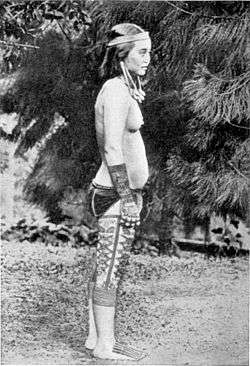Bornean traditional tattooing

Borneo Traditional Tattooing is a hand tapping style of tattooing with two sticks, developed by some of the ancient tribes of Borneo.[1]
Borneo tattooing designs
The most common of Borneo designs are thick black tribal work, which all have different meanings.
Nature is the main focus when designing a Borneo Traditional Tattooing such as leaves, animals, fruits, trees and branches.
Tattoos
The Bungai Terung, which translates to the eggplant Borneo flower, is the first tattoo an Iban individual would receive. The Bungai Terung is a tattoo which marks the Iban tradition known as Bejalai (a journey of knowledge and wisdom), where an individual would leave their longhouse to experience the world. The tattoo is located on the front of the shoulder (never the chest) to show where ones bag straps lie, to prepare the individual to carry the weight of their own world. passage of a person into adulthood. The Bungai Terung has a spiral at the center of the eggplant flower the Tali Nyawa, which means the rope of life and is identical to the underside of a tadpole which symbolizes the beginning of a new life.
All the tattoos, following the eggplant flower, are like a diary. A young male would go out on his own to find knowledge and from each place he went to he would get one tattoo to mark not only where he is from but also where he has been. From each place the tattoos have different styles so the regional differences in his tattoos would tell the story of his journeys in life.
Borneo tattoos do not just mark physical journeys. Some represent big life events, such as fathering children etc. For example, there is a tattoo a man can have done on his hand called the Entegulun. You can only have this if you have taken heads. Most tattoos are for protection, for example the tattoos on the throat (pantang Rekong) are meant to give strength to the skin on the throat, to stop the bearer's enemies from being able to sever the bearer's head. Males and Females of high status would get the throat tattooed. It symbolizes an individual who is highly accomplished in a field of their life, eg; A warrior who has taken many heads, or a great Shaman, or a headman of a longhouse, or a great carver or artist, etc. The tattoos on the back (Ketam Itit/Ketupong) represent the back of the crab, the tattoos on the arms (Ketam Lengan)represent the arms of the crab. A crabs shell is a hard armor, which protects its wearer.
Borneo tattooing today
Many of the designs no longer exist. In the 1950s and 1960s many people in Borneo converted to Christianity and a lot of the traditional tattooing stopped. The tattooing and designs almost died away. About 10 years ago there was a resurgence when a lot of journalists and researchers came and asked questions about the old ways. This caused a lot of the younger people to look back and now many of them are getting these traditional tattoos done again.
